This September and October, we’re taking a look at the jam-packed 1994 to 1995 season of Star Trek, including Star Trek: Deep Space Nine and Star Trek: Voyager. Check back daily for the latest review.
Emanations has a pretty effective set-up and solid premise. It is very clearly one of Star Trek: Voyager‘s “planet of the week” stories – like the show directly before it and the show directly following it – but it’s build around some vaguely interesting ideas. It’s very clearly an episode designed to function as social commentary in the grand Star Trek tradition, hitting on big ideas and bold concepts.
Unfortunately, it’s not the type of script that Brannon Braga is best suited to handle. It doesn’t feel so much an exploration of an important issue as a social treatise. It’s simplistic and heavy-handed while dealing with ideas that require a bit of nuance and sophistication. It feels under-developed, contrived and a little shallow. Despite an attempt at ambiguity in its closing scene, it feels like an episode driven primarily by an agenda rather than a strong story.
Emanations is a misfire, another example of the weird tendency in the first season of Voyager to assign the wrong writers to the wrong scripts.
Braga is great writer when it comes to science-fiction concepts. He likes playing with ideas of time and space – he has a knack for anomalies and phenomenon, the oddities that populate the cosmos. Braga is less good at world-building and character development. He doesn’t seem to care too much about continuity of character or the finer details of intricate character work – he seems much more fascinated by shrewd narrative high-concepts and playfully self-aware constructs.
So tasking Braga with developing a strong issue-driven story for the first season of Voyager feels like a miscalculation, much like assigning him Parallax was a miscalculation. Braga is more interested in weird science-fiction genre work than in sketching out characters. Given that Emanations hinges on how various characters react to death and faith and big ideas like that, it seems a rather uncomfortable fit for Braga’s writing style. Braga’s style would develop over the course of his work on Star Trek: Voyager and Star Trek: Enterprise, but Emanations really doesn’t seem like it plays to his strengths.
To be entirely fair, Emanations began with Braga, as something of a passion project. “I had wanted to do a show about death ever since I came to Star Trek, but I could never find a way to do it,” he contended in an interview with The Official Star Trek: Voyager Magazine. In Captains’ Logs Supplemental, Jeri Taylor confessed that Braga “really felt strongly about” the episode. It makes sense. Death and faith are two absolutely massive themes – it’s only natural to want to explore them through a vehicle like Star Trek.
The problem is that Braga really isn’t a good fit for any of this. There are some nice ideas here, most of which play into Braga’s interest in high-concept science-fiction. The idea of a culture feeding their dead into anomalies without know where those anomalies go is a great story idea – Voyager stumbling into a burial ground that is just a quirk of nature. It’s also a nice touch that the show never actually confirms where the Vhnori live. Maybe it’s nearby, maybe it isn’t. Maybe it’s another dimension, maybe it really is another spiritual plane.
Unfortunately, the rest of the episode isn’t quite that smart or shrewd. As nice as this set-up might be, Vhnori culture is functionally a “planet of the week” in the style of Star Trek: The Next Generation. Unfortunately, it’s a particularly generic planet of the week that seems to be populated by approximately three people. There are more speaking parts in Emanations, but the script is only really interested in three characters that Harry encounters on his trip: Hatil, Neria and Loria. And none of them feel particularly well-defined.
Emanations is very clearly a story driven by issues. It’s a story preoccupied with the idea of life after death, but also wants to tackle euthanasia. While both concepts are obviously linked through “death”, combining them into a single story feels a little disingenuous. After all, most organised religions tend to oppose the practice of euthanasia. While Buddhist and Hindu attitudes to euthanasia are perhaps less clear-cut than positions adopted by Christianity, it still feels like a disconnect between the stories themes and its attempt at commentary. So suggesting setting Emanations on a world where the organised religion has embraced euthanasia as a shortcut to the afterlife feels disconnected from the issues that the script is trying to deal with.
To be far, the Vhnori religion is a collection of weird religious clichés drawn from various sources. There’s a sense that they share the Christian belief in an afterlife like heaven, where they are vaguely human and get to reunite with all their loved ones; the sermon given after Ptera’s ceremony feels anchored in Christian theology and approaches to death – an organised ceremony led by a priest with echoes from the congregation.
At the same time, there are shadings of the New Age approaches and interpretations of Eastern religious philosophy that were popular in the nineties – not unlike the way that the Bajoran religion on Star Trek: Deep Space Nine resembles a sort of Westernised Buddhism. The idea of calling it an “emanation” rather than an “afterlife”, the idea that it may not be a continuation of the previous life (although it kind of is – what with family reunions all that) and the suggestion that the next life is physical and substantial as opposed to abstract or spiritual.

“Cool kids don’t desecrate burial sites for starship fuel. Knowing is half the battle. I’m Chakotay, thanks for watching.”
This sense that the Vhnori are a collection of quirks rather than a fully-formed society is underscored by other weird touches – the fact that the Vhnori burial “shroud” is designed to resemble the classical image of the mummy, and the chamber evokes a sarcophagus. The religious ritual overseen by a character dressed in bright colours which sees a person transitioning from living to deceased also evokes archetypal portrayals of human sacrifice. All of this is very effective from a visual point of view – it trades on a whole host of iconography around death – but it doesn’t gel.
There are two big problems with Vhnori culture. The big one is that it doesn’t feel like a world; feels like four actors on a couple sets talking about and enacting a collection of iconography about death, while the episode tries to make some points about euthanasia. Deep Space Nine has a similar problem with the contemporaneous episode Prophet Motive, where the show tried to convince us that Ferengi society was on the verge of being thrown into crisis while focusing on three characters on familiar sets.
What does Harry Kim’s arrival mean to wider society? How does it affect the Vhnori religious beliefs? Is he recognised as a religious sign? Is he considered a demon? A spiritual test? A rumour? A fake? “Word about you has spread very quickly, Harry, not only in the scientific world, but in the community at large,” Neria explains towards the end of the episode. “There are many people who are very nervous about what you represent. Some even see you as a threat to their beliefs about the afterlife.” It is to employ a cliché – all telling, no showing. It’s abstract.
That’s probably the biggest problem with Emanations as an hour of television. The story work in concept, but that concept isn’t grounded at all. There’s no emotional investment in what is happening, no sense that the world exists outside the sets or the vulture exists outside the thirty minutes Harry spends there. Even the show’s resolution is something that works much better in theory than it does in execution.

If this was the first thing I saw in the afterlife, it wouldn’t make me feel too comfortable either.
The idea behind the ending is solid. The script works hard to establish Harry Kim as an atheist. So there’s some dramatic irony in having him make a leap of faith to get home. Harry has no way of knowing that Voyager will be there to catch him. In fact, the episode points out just how much of this decision depends on faith – Voyager had already left before he made the leap, and it was in the process of leaving again as he made his jump. If Harry had not taken that leap at that moment, he would most likely be another dead body on the asteroid.
It is a massive plot contrivance that Harry just manages to make the leap – a nice bit of tension towards the end of an episode. Tying it into the theme of the episode – faith about what happens after death – is a nice way to justify that contrivance. Structurally, it’s almost elegant. However, it doesn’t really work. Not enough is done to stress the connection. It might have worked better had Janeway stressed that leap of faith rather than anomalous sensor readings in the episode’s closing scene.
There are also all manner of logistical questions raised. It feels weird that Kim is able to pass so effectively as Hatil, even with his face hidden. Loria talks to him before they close the chamber; doesn’t anybody find it weird that he doesn’t talk back? It also feels weird that there’s no preliminary scans or last-minute checks done before administering the “death by red glow-y things.” One imagines that you’d want to be careful about such things – it’s not something you’d want to mess up in case of confusion or mix-up.
The second problem with the episode is that it feels rather heavy-handed in its treatment of religion. In many ways, it reads like the classic “primitive superstition” stories like The Apple or Who Watches the Watchers? or Devil’s Due. That’s not inherently a bad thing – although Deep Space Nine adopts a more open-minded attitude towards religion and spirituality, everybody is entitled to their opinion on the matter. One of the great things about Star Trek as a franchise is the space it offers for a wealth of diverse opinions on various topics.
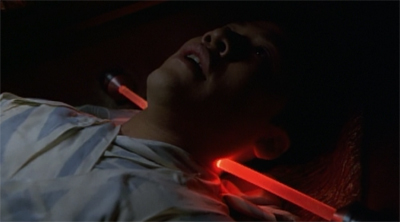
I know glow stick juice was toxic, but injecting it straight into your victim feels like a pretty crappy way to go.
And it’s quite clear that Emanations really doesn’t care for the Vhnori faith. Most obviously, there’s the fact that Starfleet are portrayed as far more advanced than the Vhnori. There is no afterlife waiting for the Vhnori, but advanced rational medicine is perfectly capable of reviving them. Science, not faith, offers a literal life after death. When Ptera is euthanised and sent through to the other side, she isn’t resurrected by her religious beliefs. The EMH – a scientific wonder himself – steps in.
“It’s a simple process, really,” the Doctor explains of Ptera. “She died of a cancerous growth on the brain stem. I removed the tumour, replicated new neural tissue and used the standard Starfleet postmortem resuscitation technique for a class five life form.” It’s clear where the answer lies in the conflict between religion and science. Harry Kim is even able to offer the Vhnori some pointers on their own scientific study of this phenomenon – despite the fact he’s only casually familiar with it, and they’ve been living with these anomalies for centuries.
This isn’t the problem, although it does feel like it might stray into the same sense of smug superiority that haunted the first few years of The Next Generation. The problem is that the episode lacks the courage to commit to this idea. It tries to have it both ways. There’s a strange energy reading written into the script so the episode can close on Janeway assuring Harry that “what we don’t know about death is far, far greater than what we do know.” It teases the faintest possibility that there may be some validity to Vhnori beliefs, as arbitrated by our Starfleet protagonists.
However, even then, there’s a sense that the episode is being a bit disingenuous. As open-minded as that final scene might be, as much as it might seem to suggest that the show is tolerant and open to possibilities, the show goes out of the way to explain that Vhnori beliefs are still indisputably and absolutely wrong. When Kes offers a version of death ritual that is roughly analogous to Christian practices (“we bury them beneath the soil, and we believe that their comra is released into the afterlife”), Ptera is clear that these are not her beliefs.
“We don’t believe in any kind of spirit,” she tells Kes. “When we die, we’re supposed to reappear as physical beings with arms and legs. That’s the whole point of sending our people through the spectral ruptures. We’re supposed to travel on to the Next Emanation as ourselves and be reunited with our families.” Therefore, the anomalous sensor reading cannot be justification of her belief system.
In fact, the ambiguity seems to exist purely so Emanations can suggest that there may be some validity to Western-type belief systems (similar to the one Kes articulates), while still entirely dismissing and belittling the faith expressed by the Vhnori. It feel a little bit cynical, a little hypocritical – a sense that Voyager is very much trying to have its cake and eat it when it comes to discussing faith and religion.
Emanations seems to argue that some religious beliefs are clearly incorrect, but the faith system that the majority of the audience subscribes to (an immortal immaterial soul outliving the flesh) could be inferred. It’s the worst possible argument for a show like this to make – to suggest that some unverifiable religious beliefs are more valid that others, because the script says so. And it just happens that the more conventional belief system (to the show’s target audience) happens to the be the one that seems more valid.
There’s also something very cynical about the conduct of the Voyager crew here. To be fair, Chakotay keeps them mindful of the burial customs of this native culture, but neither Janeway nor Kim seem to stick too firmly to Starfleet’s non-interference directives. At one point, Harry describes Vhnori customs as “chilling”, which is hardly the most diplomatic way of phrasing his concerns. While the crew stress the importance of respecting the dead, they aren’t afraid to revive Ptera if it seems like she might serve their purpose.
Similarly, Harry’s relationship with Hatil seems decidedly cynical. Harry essentially manipulates Hatil into helping him get home. Although this could not have been the plan all along, unless Harry is far more worldly and astute than he lets on, there’s something very cynical about all this. Starfleet preaches the policy of non-interference in alien cultures. However, the Voyager crew seem quite happy to interfere if it suits their ends. No one but Ptera is revived, because she’s useful to finding Harry. No one but Hatil is saved, because he’s useful to getting Harry home.
All of this is compounded by trying to graft a euthanasia metaphor into the episode. The Next Generation already handled the topic in Half a Life. While the episode was far from perfect, it had the benefit of a tight focus on character. The people involved int eh drama were well-developed and well-performed. The episode didn’t come with the baggage of having to describe an entire alien culture while telling an issue-driven story.
Of course, Emanation was airing in early 1995. Euthanasia was a hot-button issue at the time, an example of Voyager trying to put its finger on the cultural pulse. In 1994, Oregon had legalised selected forms of euthanasia, which generated no shortage of controversy. R. Cohen-Almagor offers an account of the events in Euthanasia in the Netherlands: The Policy and Practice of Mercy Killing:
In 1994, the Oregon law was approved by a 51 percent to 49 percent vote of the state residents, but was promptly put on hold amid great legal wrangling. Two days before the Death with Dignity Act was to take effect, a lawsuit was filed by a group of physicians, residential care facilities, and terminally ill Oregon residents challenging the Act of constitutional grounds. The federal district court granted a temporary injunction and eight months later struck down the Act on equal protection grounds.
This decision was subsequently vacated for procedural reasons, remanding the judgement of the district court for lack of jurisdiction. Then, in 1997, the state’s voters backed the law again, this time by a decisive margin of 60 percent to 40 percent.
1995 was the eye of this particular hurricane, and it’s not too hard to believe that the debate in euthanasia was playing out in the back of Brannon Braga’s mind as he plotted and wrote Emanations.
The problem is that Emanations feels downright reactionary in its portrayal of euthanasia. It feels like something of a strawman argument – the Vhnori are a culture fashioned from the most hyperbolic of arguments against the practice. It’s a world where euthanasia has become a cultural norm. It’s something that the entire culture is built around. Neria tells Harry that there are “thousands” of facilities like this scattered across the planet.
It’s interesting that none of those seeking suicide are in extreme physical pain. Hatil has a damaged leg and a limp – but he’s health enough that running off to the mountains is a viable option. Ptera makes no mention of physical discomfort or loss of dignity (or even debilitation) as a result of the “tumorous lesion” on her brain. Hatil and Ptera both seem to be relatively healthy individuals with afflictions that aren’t causing immediate agony or serious loss of dignity.
Instead, this is a world where social and familial pressure exists to force people to volunteer for euthanasia. This is one of the most compelling arguments against the practice, but Emanations presents it as the inevitable outcome of a culture that accepts euthanasia. Emanations isn’t even particularly subtle about it. “I have to say, this is more my family’s idea than it is mine,” Hatil explicitly tells Kim. “There was a family meeting and it was agreed that I should move on to the Next Emanation.”
“We salute not only his life, but the manner in which he has chosen to end it,” Neria offers at the ceremony. “He makes a noble sacrifice today that his family may have a better tomorrow.” That makes it clear that this society not only permits euthanasia, it actively endorses it. More than that, it finds those sorts of familial pressures perfectly acceptable. It feels like Emanations is dedicated to playing out the worst nightmares of a society that would permit euthanasia.

Boy, Jerry Hardin really drew the short straws when it come to recurring Star Trek guest actors, didn’t he?
That’s not to dismiss these concerns. These are things that do need to be debated and discussed when considering euthanasia. However, the portrayal is incredibly ham-fisted. After all, that sort of pressure tends to be a bit less overt. The Oregon law produced any number of controversial cases – perhaps the most notable was the case of Kate Cheney in 1999. However, in that case, even the doctors couldn’t agree on whether there was undue pressure at work. That sort of situation requires nuance and ambiguity – attributes for which Emanations has little time.
Emanations feels like a heavy-handed treatise that is more interested in lecturing its audience on its stance on a particular issue than telling a story that explores the concept. There’s no room for sophisticated discussion about the controversial (and divisive) topic. It feels like a waste of what might otherwise have been an interesting concept, preventing Emanations from fulfilling the potential of its premise.
It’s a shame, because there’s some nice stuff here. The visuals are quite striking – the sight of the bodies strewn across the caves inside these asteroids is atmospheric and effective. It’s also interesting to see Voyager continuing to play with decidedly old-fashioned storytelling tropes. Since Caretaker, the show has been careful to portray the Delta Quadrant as a spiritual successor to the Wild West, with occasionally problematic results. The natives are primitive, the technology is backwards, resources are scarce. The Ocampa home planet is a desert.
To be fair, this doesn’t always work out for the best. Sometimes this makes Voyager seem a tad imperialist – the burden of a civilised culture in uncivilised space. It also contributes to the borderline racist portrayal of the Kazon – who are constructed to simultaneously evoke stereotypes about native culture and Los Angeles gang culture. After all, the imagery associated with the Old West is inexorably linked to concepts like “Manifest Destiny” and other problematic historical concepts.
It’s to the credit of Braga that Emanations manages to play into these themes while recognising the problematic aspects of it all. The imagery of caves filled with dead bodies evokes the notion of Native American burial caves; although by no means unique to Native American culture and tradition, they are found across the United States. Many of these sites have since been desecrated, whether for looting or by thoughtlessness.
It’s nice that Emanations acknowledges this – with Voyager almost absentmindedly desecrating the site through their pursuit of knowledge and materials, only to stop and respect Vhnori traditions. It does feel a bit weird (and maybe a little stereotypical) that Chakotay has to step in to speak for the native people. One would imagine Starfleet should really be teaching this sort of rudimentary respect at the Academy.
Still, it’s nice to have the idea expressed and acknowledged – and to concede that self-proclaimed “advanced” cultures are liable to overlook such things. It’s also nice to get a little more information on Chakotay. The character disappears into the ether rather quickly in the first season, as Brannon Braga confessed to Cinefantastique:
“He’s the one character we have been struggling with most,” said Braga. “There is a danger because we have, in essence, two Captains on the bridge; the senior Captain who gives all the orders, and Chakotay. What does he do? So it is the the Riker syndrome, somewhat, but he has a whole dimension that Riker didn’t have when TNG began, which is his spartan, spiritual/ technological endeavors. You are not sure what Chakotay is about. He is very internal, reserved; you know he’s got a lot going on inside, but we don’t know exactly what. It’s good to have an enigmatic character. Maybe he will become our Guinan.”
That said, making him an anthropologist is a nice piece of character development that feels reasonably organic. After all, if Voyager is going to push Chakotay as the show’s go-to-guy for sensitivity about native cultures, an interest in anthropology feels more comfortable a justification than “he’s Native American.” Of course, like so much about Voyager, it’s an interesting idea that is used once in a context where it’s handy and never really developed from that point.
Still, despite these interesting attributes, Emanations can’t help but feel like a particularly cynical “planet of the week” story, one that doesn’t work hard enough to develop the culture it examines, and feels too calculated to really work on its own terms.
You might be interested in our other reviews from the first season of Star Trek: Voyager:
- Caretaker
- Parallax
- Time and Again
- Phage
- The Cloud
- Eye of the Needle
- Ex Post Facto
- Emanations
- Prime Factors
- State of Flux
Filed under: Voyager | Tagged: afterlife, Brannon Braga, chakotay, death, emanations, Euthanasia, native americans, old west, Oregon, star trek, star trek: voyager, voyager |















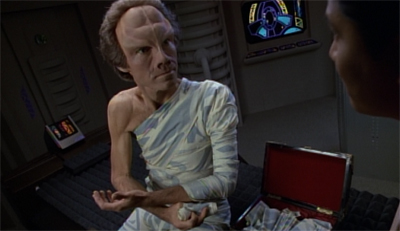


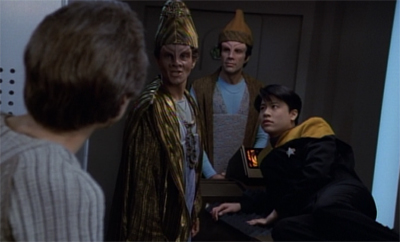
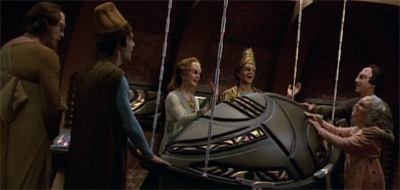


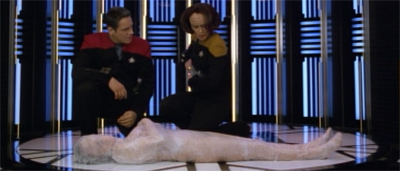
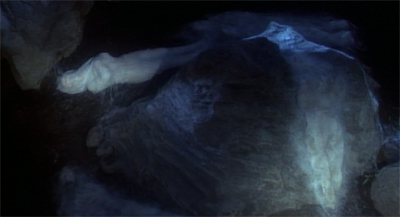

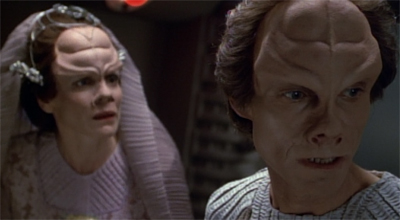
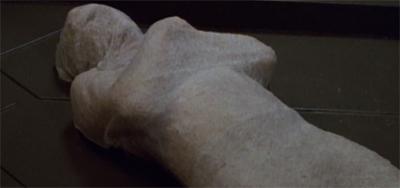







The popular criticism of the show is that it abandoned its premise too early. Episodes like this prove why they right to make it sillier. This is just grotesque. The moral is outdated (and mad, but that’s my personal opinion), the ham-fisted approach renders the overall message…well, repellant, and it’s compounded by Chakotay’s thinly-sketched spiritualism. The toxin is built-in, the show can’t be salvaged as a social work.
A dramatic work, maybe.
That’s a good point, but I’d be reluctant to throw the baby out with the bath water. Emanations is pretty woeful, but I’m not sure it demonstrates the show is past salvageability. Profit and Lace doesn’t invalidate Rejoined, hopefully, on DS9. Code of Honour does not irreparably taint TNG.
I’ll agree with you that there aren’t any moments in the first season where the show’s basic premise (two crews stranded together on the opposite side of the galaxy) works, but I think there are moments where it brushes up against working. State of Flux would probably come closest, if they kept Seska on the ship at the end instead of running away with “Kazon Gul Dukat.”
It may be worth noting that not all Western religious traditions teach an immaterial afterlife. Christian orthodoxy also references physical resurrection and rebirth — “New Heavens (i.e., the universe) and a New Earth.” Some theologies take that concept very literally, teaching a literal re-created universe just as physical and real as this one, inhabited by physically resurrected humans whose redeemed form will be perfect but not immaterial.
Though, I can’t argue that spiritual afterlife isn’t culturally normative, especially since I come from a tradition where they teach that people are going to be disappeared out of airplanes and clothes.
Very fair point. I should clarify “Western” to “Christian”, probably. My bad.
Emanations was the first episode of Voyager I ever saw, but it was a while before I fully committed to watching the show. Have you ever read the book Delta Quadrant: The Unofficial Guide to Voyager by David A. McIntee? It’s quite an enjoyable read even though it only covers the first five seasons. McIntee really enjoyed Emanations; in fact, it was the first Voyager episode he gave 10/10 to (a rare thing indeed). He called it the VGR equivalent of TNG’s The Inner Light or DS9’s The Visitor, although he disliked the way Ptera was written out, as if Brannon Braga didn’t know what to do with her (another example of Braga making things up on the fly). VGR would revisit the theme of euthanasia next season in Death Wish, which pays much more attention to the consequences of interfering with the status quo.
I have a suggestion Darren for a caption under the picture of Ptera first waking up on Voyager, expecting to be in the afterlife and instead seeing Janeway and the Doctor – Star Trek: The Next Emanation.
Ha! Love the caption idea!
Interesting that McIntee liked it so much. I know you’re quite fond of it from past posts.
Personally, I’d put Projections and Meld as the first truly great Voyager episodes.
A transuranian element as the result of body decomposition? Hm…. sounds extremely insane. Paris was ordererd to get Voyager away from the asteroid at least half a lightyear. It took Voyager a few seconds apparantly. Very inconsitent with 70 years for 70.000 lightyears…
Still I rather enjoyed this episode, now more than when I was younger. Especially the last scene between Kim and Janeway was very well written and played and all in all very affecting and inspiring. New age or not – leaving open the possibility of an afterlife via a sci-fi explanation was pretty interesting, almost in a DS9 way. It gave the new agey allusions a bit of an earthing…
Yep, as I’ve noted, the franchise has a somewhat… novel grasp on concepts of scale. It becomes more obvious when they run into races like the Malon or the Hirogen scattered across dozens of thousands of lightyears in the Brannon Braga years.